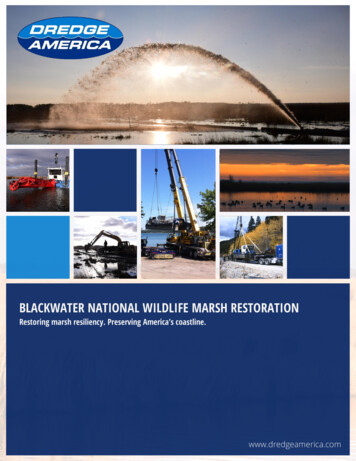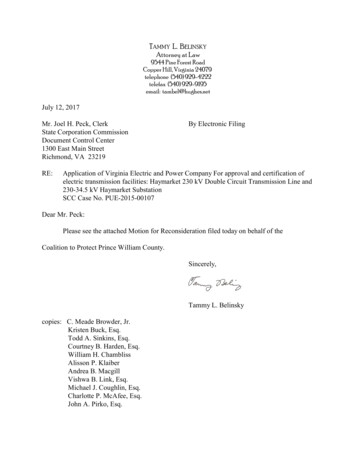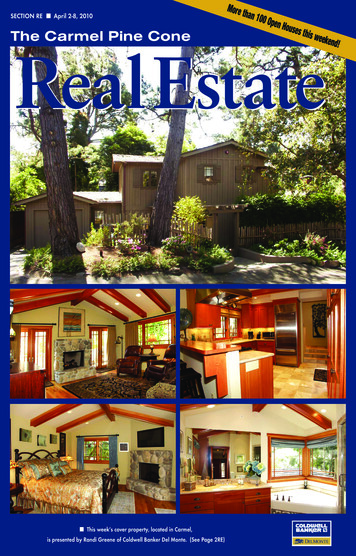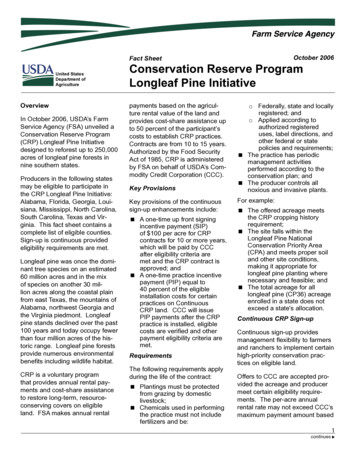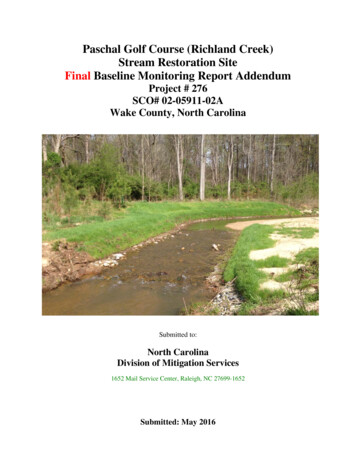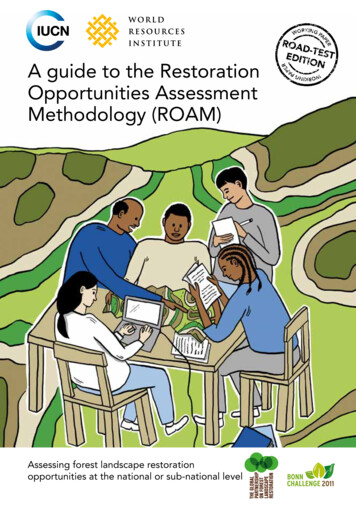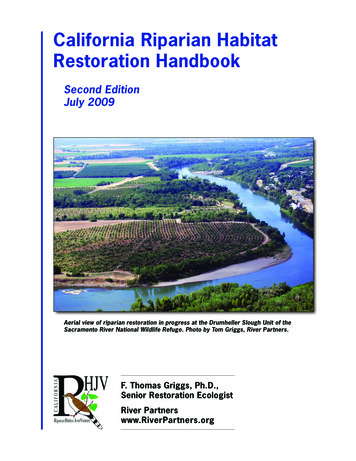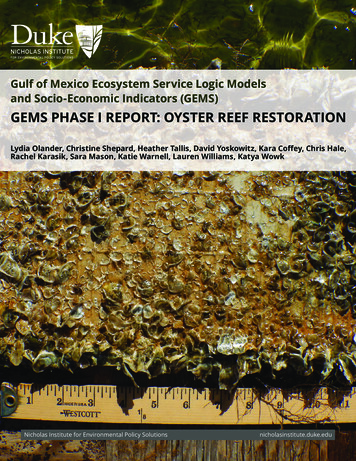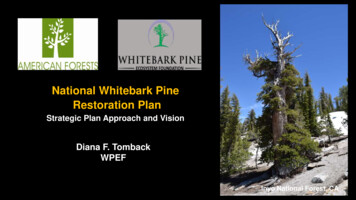
Transcription
National Whitebark PineRestoration PlanStrategic Plan Approach and VisionDiana F. TombackWPEFInyo National Forest, CA
Rationale Whitebark pine health is deteriorating rapidly. The widespread decline in whitebark pine comes from anunprecedented combination of threats and requires timelymanagement intervention. Restoration of whitebark pine poses logistical and fiscal challenges,given the magnitude of its distribution and budgetary constraints. These challenges require a strategic approach to restoration,emphasizing designated “core” areas, which will have the highestpriority for restoration activities.
Objective American Forests, the Whitebark Pine Ecosystem Foundation, andthe U.S. Forest Service are partnering to develop a core arearestoration plan for the U.S. distribution of whitebark pine (Pinusalbicaulis). Collaboration includes all federal and state agencies and tribes withwhitebark pine under their jusrisdiction. This strategic plan will identify selected areas within the U.S. rangeof whitebark pine for priority restoration, focusing resources.
Anticipated components to the plan A geographic restoration plan (GIS layer) depicting nominated coreareas for each administrative jurisdiction within different agencies,based on agency-specific criteria. Priority designations within each core area (1 through 3). Nominated core areas will represent about 20% to 30% of whitebarkpine’s distribution in any administrative unit. Narrative for each administrative jurisdiction includes criteria used toidentify core areas, and specific restoration protocols assigned tonominated core areas. Estimated implementation costs for these restoration protocolsacross prioritized areas. Monitoring and adaptive management substrategy.
Overview of process and productsCollaborativeengagementOnline surveyRestorationactions: BMPsRestorationplan reportNationalWhitebark PineRestoration Plan&ImplementationAssembling dataand narrativeTeleconferencecore areaworkshopNational Summit:call fornominated areasTeleconferenceswith regionsand NPS
Components to planNominated coreareas from eachjurisdictionMonitoring andadaptivemanagementstrategiesImplementationcosts for restorationaction acrossnominated areaPriority designationwithin each nominatedareaCore arearestorationplanProposedrestoration actionswithin core areasCriteria usedto identifycore areas
Scope of work: Phase ICollaborative engagement. Outreach by letter by the WashingtonOffice of the US Forest Service to the NPS, BLM, US F&WS, tribalgovernments, and state agencies describing process and timetable.Survey, workshop, and discussion groups. Online survey. This survey helped determine gaps in information onwhitebark pine distribution and health status and the resources neededto fill gaps. Completed. Conservation and restoration— Best management practicesworkshop: Experts on different restoration actions provided their viewon implementation of various practices. Completed. Regional discussion groups (Regions 1, 2, 4, 5, 6, NPS):Teleconferences with regional offices and the NPS. Presented a seriesof questions to ascertain current projects, plans, and thinking aboutwhitebark pine. Completed (but open to additional groups)
Scope of work: Phase IINational Summit, in progress Brings together high level representatives and resourcemanagers from the Forest Service, National Park Service,Bureau of Land Management, Fish & Wildlife Service, and tribalgovernments. The major emphasis is on the rationale and conceptual basis forthe proposed strategic plan, the development of selectioncriteria for core areas, and the description of the process. After the summit, there will be a formal request fornominated core areas from all jurisdictions.
Scope of work: Phase IIITele-conference core area workshop. Early/late February,2018. TBA This will provide an informal opportunity to answer questionsand provide feedback concerning the process of identifyingpotential core areas. We can help agencies and units as they identify appropriatecriteria for nominating core areas, assigning restoration actionsand protocols, and information gaps.
Scope of work: Phase IVCompile National Restoration Plan The Whitebark Pine Ecosystem Foundation and Forest Servicepartners, in consultation with American Forests, will integratecore area information as it is received, as well as otherimportant information, into the range-wide (national) restorationplan. The final plan will be reviewed by all partners. Comments will be integrated as the final plan is drafted.
Scope of work: Phase VPresent Plan to Leadership, December 2018 Present final plan and begin discussions of implementationstrategies. US Forest Service, American Forests, and the Whitebark PineEcosystem Foundation will reconvene participants from the2017 Whitebark Pine Leadership Summit to present the finalrestoration plan. We will begin conversations about funding and devising animplementation plan.
Final products Conservation Restoration Management Actions: Best ManagementPractices summary-WPEF General Technical Report: National Whitebark Pine Restoration PlanWPEF Summary for public outreach-AFThese products should provide the basis for a strategic prioritizedrestoration approach for each federal agency and tribal jurisdiction. These products signal the beginning of restoration work. Restoration implementation will still require collaboration,partnerships, and outreach. These final products are just the beginning of the real work.
Developing the data setsneeded for the NationalWhitebark Pine RestorationStrategy (NWPRS)Bob KeaneUSDA Forest ServiceRocky Mountain Research StationMissoula Fire Sciences Laboratory
The National StrategyMajor Deliverable:Prioritization of areas for restoration atmultiple scalesDemands a scientifically credible approachbased on empirical data and comprehensivestatistical analyses
National WBP Strategy DatabaseSpatialDataModeling &StatisticalAnalysisProgramsNonspatialData
National WBP Strategy odeledPlotData
NWPRS DatabaseTarget scale of analysis Wall to Wall Map resolutions 1 km (30 m) pixel Analysis unit 6th code HUC Summary units District Nat Forest, Park, etc Region Range
NWPRS DatabaseExisting Spatial Data Multiple resolutions 1 km, 30 m, 100 m Wall to wall Represent allimportant factors Include climatechange layers Includes existingmodeled layers Probably won’tinclude CanadaFinal Product: A GIS library of all the layers needed toprioritize landscapes across the range of whitebark pine
NWPRS DatabaseSpatial Data from the field WPEF developed layers Contains all informationsubmitted from the field Synthesizes thatinformation for use in theprioritization process Documents availabledatabases and spatial datalayers
NWPRS DatabasePlanned application Integrate spatial datalayers into aDecision-SupportSystem (DSS) Use the EMDSsystem Available freeWeb site: http://emds.mountain-viewgroup.com/
Jan 03, 2018 · Compile National Restoration Plan The Whitebark Pine Ecosystem Foundation and Forest Service partners, in consultation with American Forests, will integrate core area information as it is received, as well as other important information, into the range-wide (national) restoration

